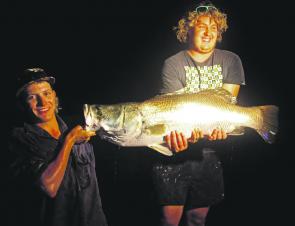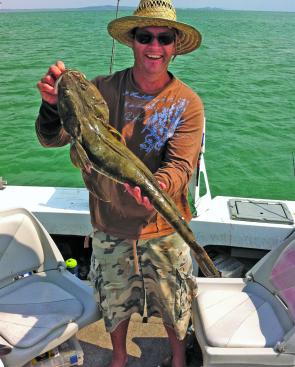The prediction for this month is rain and more rain, which usually takes the initiative away from the average fisher. The trick is to work with the conditions and think where the fish are likely to be - they still need to feed regardless of weather.
Species like barramundi will stalk the areas where the fresh drains into the salt rivers and creeks. Last year this became very evident when the mouth of the very fast freshwater flowing Moore’s Creek became the hottest spot around Rockhampton to score a quality barra. There were a number of similar situations heading down the river where the guys who braved the conditions had some fantastic once in a life time catch and release sessions landing upwards of 30 fish in a couple of hours. Since the barra season is still closed use these ideas to target other stuff like king salmon, which cover a similar range.
On a recent run down the river we found that there was a big salmon in nearly every gutter or muddy drain, sometimes sitting still in ambush mode in as little as a few 100mm of water. We were looking for baitfish and several casts with the net in different gutters produced a salmon up to a metre long. We tried plenty of different lures without results until the plastics came out. Surprisingly the more fluoro plastics were ignored but as soon as a more natural almost invisible 3” Atomic Prong hit the water it got smacked big time. When we finally found a few prawn fry and soaked them in the dirty water these were slammed as well.
The guys who chase salmon with success look for eddies around the rock walls and structures combined with dirty water moving out of a gutter.
Wherever you see hundreds of golf ball sized dints in the mud as the tide drops, it’s a good idea to soak a bait because that’s a sign the king salmon are feeding there. The dints are created when the salmon slams the bank to stir up the prawns, crabs and other tasty critters likely to make a feed.
Salmon are among the first fish to get very active when a change in conditions occurs. Whether it’s a drop or rise in surface pressures or flooding rains you can rely on king salmon feeding. The jetty rats always score quality salmon almost all year at night. The big kings cruise right along the front and under the wharf using the pylons as ambush points. Live prawns are the best bait although small crabs, little poddy mullet and fresh frozen prawns are a very good backup.
Grunter are becoming more active as we move into the hottest period of the year and can be caught in most of the local estuaries and rivers. Heading downstream from the town reaches is Pirates Point, which is probably the best starting spot for grunter. The movement of the river has created big undulations where grunter lie in wait under the main current for edible morsels and small fish or prawns to get washed in. In the main part of the river there are a lot of these areas right down past Nerimbera. The next area where grunter hunters do well is the Port Alma, Connors and The Narrows. These areas are much like parts of Coorooman and Corio where grunter are caught regularly. The big currents and tides create rubble beds in the deeper holes and grunter can feed here like the undulations up the river, underneath the fast flow. Grunter eat most baits although any decent fresh prawns continually outperform just about everything else.
One of the top tier estuarine table fish is fingermark, or golden snapper to the territory guys. These fish look like an odd coloured jack and once hooked they keep nothing in reserve as they try any dirty tactic they can to get back down to the rocky bottom. Fingermark love a rubble bottom and they use the rocks or holes to stay out of the faster currents. The Fitzroy has a lot of fingermark spots but the area around Port Alma, Connors Rocks, The Narrows and the islands in the delta are prime territory. The better fingermark start to move offshore and some of the local wrecks hold huge fingermark mixed among the mangrove jack.
Fingermark will take plenty of different baits especially live prawns, herring or poddy mullet. Trolling lures is my favourite method for chasing fingermark. The trick is to get the right lure that will nudge the bottom occasionally as you troll over the likely ground. Richoes deep diving Extracta or a Manns 20+ seem to get more fingeries than my other lures so I normally tow one of each depending on depth. Around the headlands where the water can be quite shallow you really need to watch the sounder to pick the right lure. Coorooman Creek and Corio Bay also hold fine fingermark and often get caught while live baiting for barras or jacks. The closer islands off Emu Park also hold fingermark and we find that trolling allows you to cover more ground until you locate them. Another tip is to try the local night time jew holes during the day.
Queenfish have continued their good form through December with fish a kilo or so turning up in the estuaries to the big brutes up to 6-8kg around Corio Heads and The Keppels. Queenies like live herrings, hardyheads, yabbies or whiting - they rarely if ever take dead baits. The best option for bait fishers is to catch the bait and then find the fish.
The most exiting way to target queenfish is with lures. Poppers or Flashas work the best either from the beach or the boat. If you can get a decent drift past any headland with a little bit of white water then your chances improve dramatically. One of my crew stands at the front of the boat casting poppers while the kids sit down with a lightly weighted live greenback herring hanging out the back. The kids quite often beat dad especially when the school follows the popper and spot the herrings.
From the beach at Keppel we look for the schools of hardies and flick small plastics that look like a natural bait fish into the middle. Let your plastic sink down through the school and sit on the bottom for a second before giving it a couple of small twitches then let it drop again for a few seconds. When queenies are on it doesn’t take long for them to spot the plastic and savage it.
I take a two-piece 2kg outfit over to the islands and walk from where the tourist boat lands along the beach to the heads and back flicking around any of the bait schools. I never miss out on a feed using this method and it fills in time while the crew has a camp in the shade after lunch.
The offshore fishing is still going strong with the reds, sweetlip, trout and pelagics all firing at present. The bigger stuff is out wider over summer and the grounds this side of the shoals seems to be the go.
The estuaries are also in great shape as the mud crabs are nearly all full while bream, whiting, flathead and blue salmon are chewing. The exceptional barra season last year continues through the closed season as they are smashing lures meant for jacks and fingermark even in places where you don’t expect barras. This should represent a great looking immediate future once they are on the menu again. Enjoy the rest of the school holidays and have a prosperous New Year.
Reads: 2741
Sammy Weise with a solid Yeppoon red emperor.

Rockhampton locals Thomas and Jake Dwyer about to release this 108cm locally caught barramundi.

David Plant with an awesome flathead caught just north of Yeppoon.




